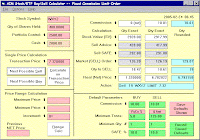
AIM Stock/ETF Calculator Version 8.1 Available
The Premier AIM Stock/ETF Buy/Sell Transaction Calculator Program has been updated to v8.1.
This software program implements Robert Lichello's Automatic Investment Management (AIM) algorithm, with enhancements.
AIM is a Core Position Trading (CPT) method where investors are "forced" to "buy low sell high" portions of their core positions in stocks or ETFs. A portion of their holdings is to be sold on rallies (selling high) and repurchased on dips (buying low), to ensure long-term gains.
Previous purchasers of the program have received an email with a link to a web-page having the software download and other links.
Other investors interested can discover what AIM is all about and purchase the software by starting at AIM Calculator Software Program for Stock Trading and ETF Trading.
Updated Items
Previous purchasers, note that several other items have been updated:
The screen-shots on various web-pages have been updated.
The program description is updated at:
AIM Calculator Software Program for Stock Trading and ETF Trading.
The program user document is updated at:
Stock and ETF AIM Trade Management Software User Doc.
The important page discussing what trades to consider, and which to not, is updated at:
Stock and ETF AIM Transaction Price Range Calculation.
The sample Price Range Calculation listing is updated at:
Sample Price Range Calculation listing.
The handy spreadsheet for summarizing your positions and next transactions has had a face lift by color-coding the spreadsheet cells to clarify which cells are for user input and which are protected. That is available only to purchasers of the software, but the update user document is at:
AIM for Stocks and ETFs Position Overview Spreadsheet User Document.
Update Summary
The main screen has been given a face-lift.
* A few of the user input text boxes have been re-arranged.
* The color scheme of the input text boxes has been simplified.
* An additional input text box for the Previous Transaction Price has been added. That accompanies the Previous NET Price text box.
* Two of the results columns have been greyed out to clarify that they are for information only, not for action.
* An "Action Analysis" box with additional information replaces the information pop-ups for that information.
The Price Range Calculation listing has been revamped.
* The heading display lists the items in the same order as on the main screen.
* Two table columns that displayed reference information have been removed. If a user is really interested in that information, the user may get it from the main screen "Exact Qty Calc" results column for a given Transaction Price Calculation.
* The last two columns previously give "% diff" and "$ diff" have been replaced with three columns under the general heading "DIFFERENCE CALCULATIONS". The two colums just mentioned are now named "Net %" and "Net $". The added third column is "Trans %", which shows the percentage difference between the Previous Transaction price entered on the main screen and the proposed transaction price for the table row of interest.
* Warnings are appended to each line where a potential transaction is not recommended.
* The warnings are described in the Notes at the bottom of the Price Range Calculation listing.
Questions? Comments?
Feel free to use the Comments section for questions and comments, and suggestions.


















